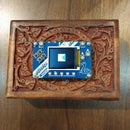Introduction: Computer Control Any Electronic Circuit Kit
CHECK OUT MY UPDATED INSTRUCTABLE...
I really love simple electronics kits like the Tronex 72+ Science Workshop from Tedco Toys. Besides being easy to use, the Tronex has just enough components to prototype projects very quickly because you don't have to chase down any parts since they are literally bolted to the board. Spring connectors make it easy to connect up a circuit. Plus, expanding and adding parts to it is really easy... just wire any small breadboard. In this really simple instructable, I'll demonstrate how to add computer control to any switch operated circuit project you build with the Tronex or any other electronics breadboarding kit. Also check out Control Snap Circuits With A Circuit Playground Express.
Step 1: Parts Needed for This Project
For this project you will need:
- Tronex 72+ Science Workshop
- LCA710 Solid State Relay chip (mounted on any small breadboard)
- 1K Ohm Resistor
- Adafruit's Circuit Playground Classic loaded with Reach and Teach's RTPLAYGROUND software (or your own favorite controller if you have one)
A complete kit of parts can be purchased here
The LCA710 is a really easy to use solid state relay. It requires 1.4V to turn its internal switch ON. For this reason, you will need a 1K Ohm resistor between the Solid State Relay and your microcontroller's digital output.
For the controller, we are using Adafruit's Circuit Playground Classic loaded with the RTPLAYGROUND software from Reach and Teach. The Circuit Playground Classic is an Arduino with all sorts of sensors, digital and analog inputs and outputs, switches, and colored LEDs already built into the board. The RTPLAYGROUND software makes it easy to prototype a number of different type of projects using this board without having to write code. You simply select the program function you want and you're ready to go.
You can purchase a Circuit Playground Classic that is already preloaded with the RTPLAYGROUND software at the Reach and Teach website. If you already have a Circuit Playground Classic and you know how to load Arduino sketches using Arduino IDE, you can download the RTPLAYGROUND Arduino sketch on GitHub.
If you are using another controller (arduino, raspberry pi, etc), these instructions will still work except that you will be attaching your own controller to the LCA710 chip and you will need to write a little code to control it.
Step 2: Wire Up a Circuit on the Tronex
For this example, we just wired the negative end of the battery through the pushbutton switch to one side of the motor. The other end of the motor is connected to the positive end of the battery. Pushing the pushbutton should cause the motor to spin as expected. Of course, you can wire up any circuit. We will just be replacing the switch with a computer controlled switch.
Step 3: Attach the LCA710 Switch to the Tronex and Circuit Playground
Simply wire pin 4 and pin 6 of the LCA710 to the Tronex pushbutton switch as shown. Alligator clip pad #6 of the CIrcuit Playground Classic through a 1K ohm resistor to pin 1 of the LCA710. Attach pin 2 of the LCA710 to any of the pads marked GND on the Circuit Playground Classic.
If you are using another controller (arduino, raspberry pi, etc) instead of a Circuit Playground, attach a digital output pin from your controller through a 1K ohm resistor to pin 1 of the LCA710. Attach pin 2 of the LCA710 to the ground pin on your controller.
Step 4: Configure the RTPLAYGROUND Software and Test
Power on the Circuit Playground and select program function 3 (Contact Tag) on the Circuit Playground Classic as described in the RTPLAYGROUND documentation. Using this function, touching pad #3 and ground at the same time (or grounding pad #3 by any means) will cause the digital output at pad #6 to toggle between digital high and digital low which in turn will operate the Tronex circuit. Alternatively, program function 4 will allow you to activate and deactivate the switch by pointing a flashlight or laser at the Circuit Playground's light sensor.
If you are using another controller (arduino, raspberry pi, etc) instead of a Circuit Playground, you'll just need to write a little code to drive the digital output pin on your controller to HIGH to turn the motor on and LOW to turn it off. This circuit should successfully work with an input between 3.3V and 5V.
And, that's all there is to this demonstration of how you can easily computer control a Tronex basic electronics kit.











